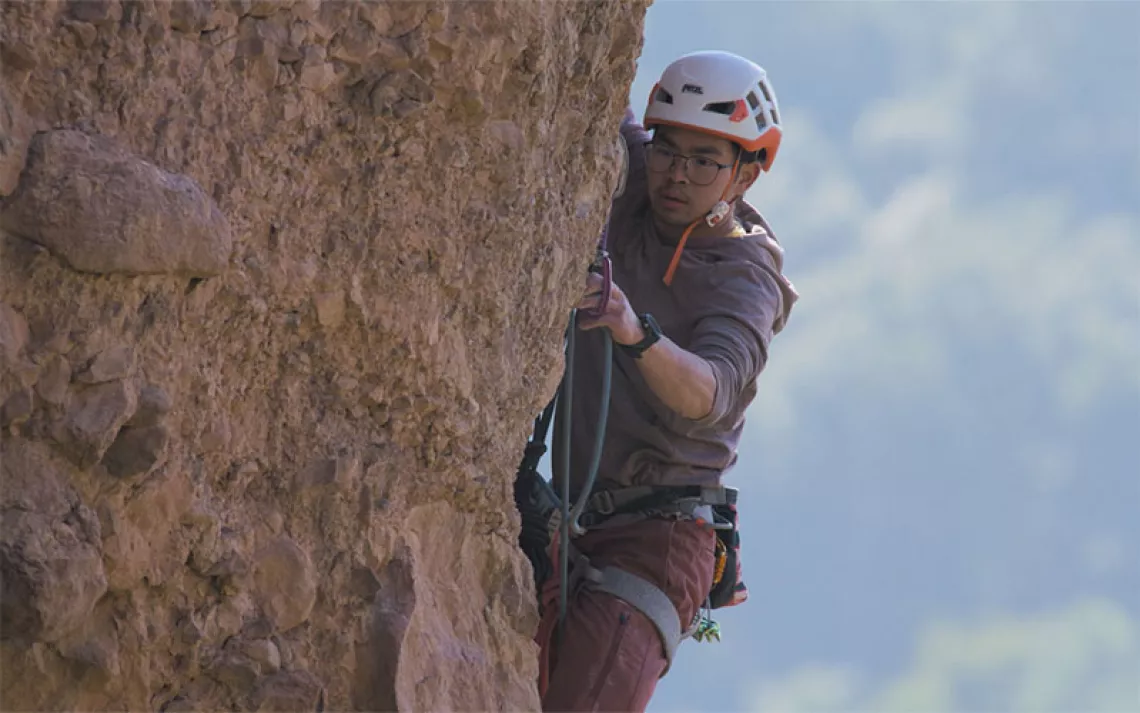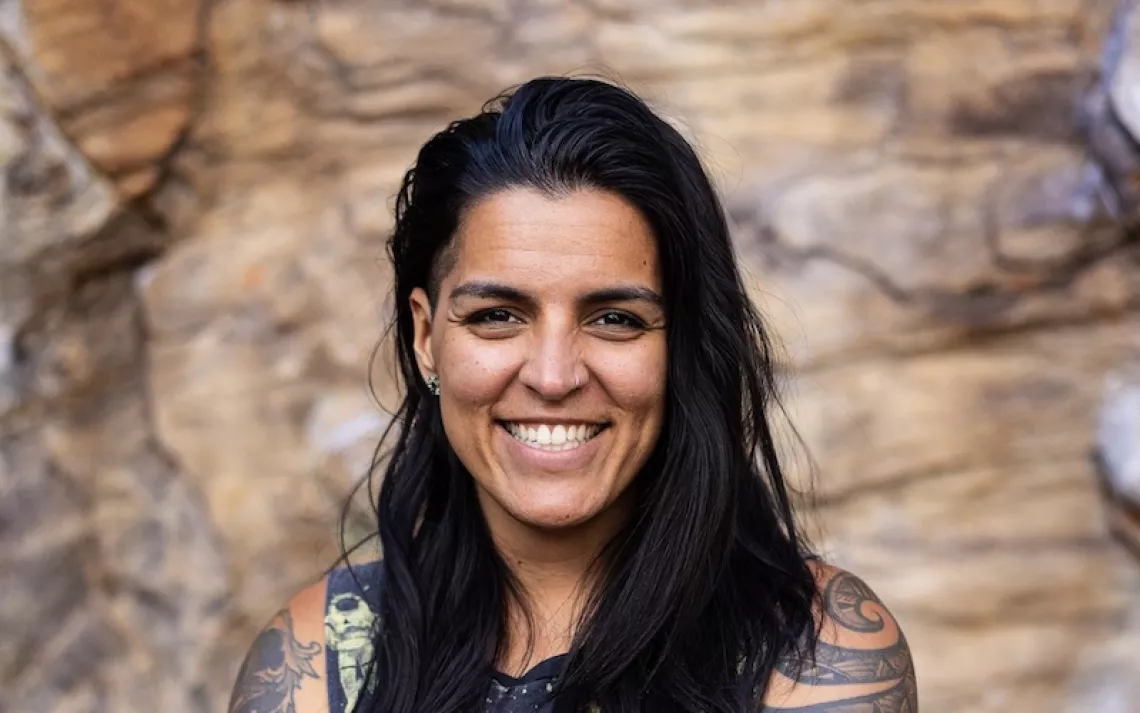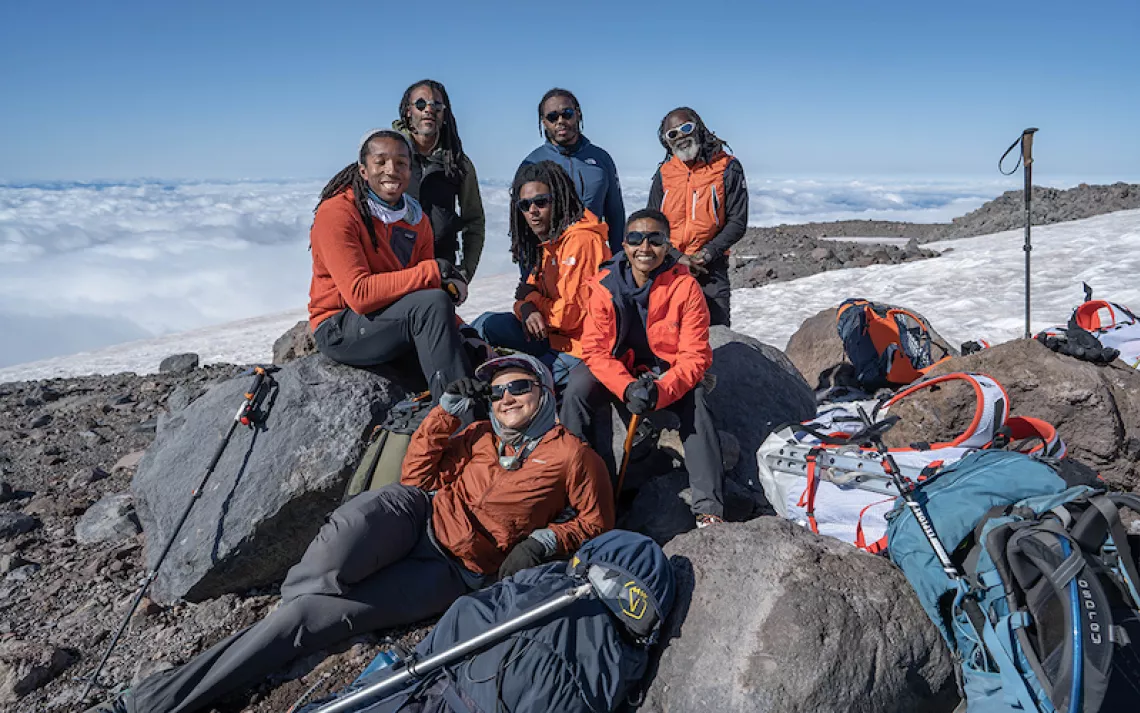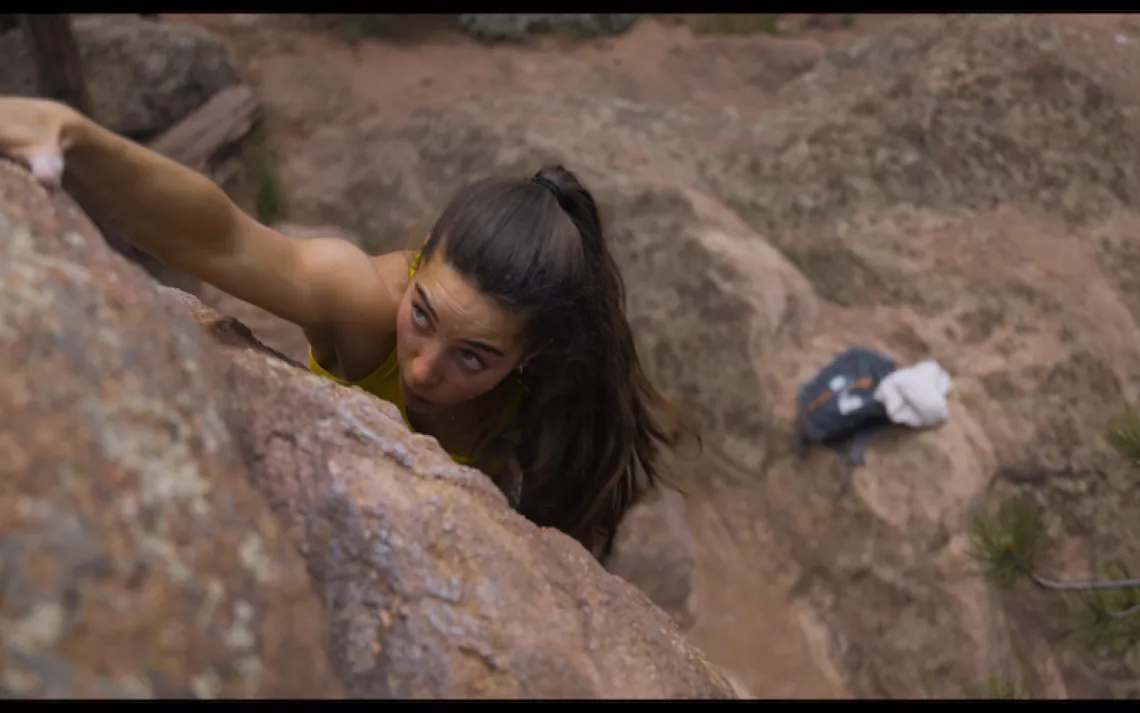Climbers with Disabilities Have Equal Footing at Ouray Ice Park
Meet Ouray’s Paralympic hopefuls, amputee ice climbers, and cancer survivors

Ouray Ice Park | Courtesy of Daniel Chehayl
“Whose foot is this?” my climbing guide, Danika, asks.
She’s referring to the prosthetic ankle and climbing boot seemingly abandoned in the snow. Behind the boot is a rusted bench. Behind the bench is an icy and vertiginous path that leads to the base of the Uncompahgre Gorge and the amber river that’s frosted within it.
It’s another perfect day in Ouray, Colorado. The sky is bright blue, the San Juan Mountains appear stacked in neat layers of rock and ice, and the trees are topped with beautiful tufts of snow that look like they’ve been placed by professionals. In Ouray, this is not such a crazy notion. Each year, beginning in November, a committed group of climbing enthusiasts unite to transform the deep mountain canyon that is the Uncompahgre Gorge into an ice-climbing mecca. The frozen icicles that Danika and my mother and I have been attempting to climb are artificial. PCV pipes run the length of the gorge, directing water away from the Ouray Hydroelectric Plant and into sprinklers. They’re just like the kind you’d stick on your lawn, except instead of keeping grass up to neighborhood code, they serve to drip water over cliffs, creating the biggest ice-climbing park in the world.

Uncompahgre Gorge | Courtesy of Daniel Chehoyl
Ouray Ice Park boasts more than 200 routes. There’s the kids' wall, where white ice tumbles like a chandelier for 50 feet, and the “Schoolroom,” where waterfalls stream in frozen layers to the floor of the gorge. There’s the lead-only area where climbers scale 150-foot pillars of alternating gray-blue and white ice, the individual icicles overhanging one another and sheering off in various directions. And there are the mixed climbs—the ice so delicate you can’t slam your tools in; thin columns of frozen water speckled with air pockets that end above wet rocks. Here, climbers ascend by jimmying their axes into cracks and placing their crampons’ front points onto nearly invisible nubs.
This is where we’ll be spending the afternoon.
But before we hike over there, we stand beside the lone foot and watch as five people sporting puffy jackets, harnesses, and helmets conclude their climbs. Their skin is flushed red and some bear the telltale signs of ice climbing: cuts and bruises, care of misplaced axes that’ve popped from the ice to slam into the soft skin of their faces.
They shuffle past the foot lodged into the snow, not staring at it but not not staring, either.
A few yards away, Kirstie, a Paralympic hopeful snowboarder and Afghanistan War veteran, side-saddles a red snowmobile and speeds down the narrow track toward the foot. Danika squints at Kirstie’s lower half. She seems to ascertain that her prosthetic is indeed attached, because Danika bends to the snow and picks up the abandoned one.
“Did Jeff leave his foot?” she asks.
The climbers in the puffy jackets don’t know Jeff. They shake their heads and adjust their helmets and begin cramponing down the snow-covered track, after Kirstie.
I stare at the sole cradled in the palm of Danika’s hand. The metal bone of the foot is just visible above the brown leather boot. It’s narrower than ankles seem like they should be, a reminder of the fragility of bone.
More puffy jackets emerge from the gorge. One determines that Jeff is still climbing and will collect his prosthetic in a bit.
The foot is returned to the snow, whence it came, and Danika, my mother, and I continue on, setting an anchor to begin a climbing route situated between “Baby's Butt” and “Jesus Built My Finger Crack.” No one seems to remember the name of our route. I wrap a piece of black nylon, the thickness of a pencil, around a tree. Tied correctly, this can hold a falling bus. Tied incorrectly, it can lead to a fatal fall like that of the late Ouray resident and guide Gary Falk, whose knot failed in 2016 while guiding three students down the Grand Teton.
We clip our harnesses to the nylon and lean back over the climb. The ice cascades below us, tumbling down in smooth rivets.
If you can get past the feeling of your bare hand on the cold, blue ice, the frozen waterfall feels like velvet. I close my eyes and wonder what Gary Falk thought as he fell—if he imagined the smell of his kids’ hair, or remembered what it's like to sip something warm, or to have his hand squeezed by someone small and sticky.
 Danika throws our rope down. It lands close to my mother, who finished chemotherapy for throat cancer six months ago. She’s now a tiny dot in an orange helmet (pictured right).
Danika throws our rope down. It lands close to my mother, who finished chemotherapy for throat cancer six months ago. She’s now a tiny dot in an orange helmet (pictured right).
Danika rappels toward her. I decide to take the long way, watching puffy jackets reach the top of their climbs, their eyes shining like they just did something big.
As a sport, ice climbing demands a level of trust similar to that which a passenger employs while traveling by jet—just as it’s best not to question whether a sleep-deprived maintenance worker has failed to properly shut the fuel tank on your 747, it’s best not to wonder whether a previous climber has stuck her ice axe through your rope.
The climbs in the Ouray Ice Park are tended by “ice farmers”—the climbing equivalent of Telluride ski bums. On busy days they patrol the gorge, walking from the parking lot to the bridge, past the fire pit, the lead-only area, and along the bear-size rusted pipe that runs the length of the gorge. Their job isn’t to check anchors—it’s to make sure no one’s hogging an area so that everyone, regardless of skill, ability, or fame, can climb.
The biggest risk factors in the park are errors of judgment—a climber unclipping from a belay before actually climbing out of the canyon, or a tourist shuffling too close to the slippery edge.
Since the park’s official inception in 1997, there’s been only one deadly accident but plenty of nonfatal ones—the daily bruised knees (imagine kicking a wall of ice as hard as possible and hitting kneecap instead of boot) and the bruised cheeks, chins, and eyes, care of poorly placed ice axes that slip from their holds in the ice. There was the climber at a recent ice festival who leaned back over the canyon as if to rappel, found the rope unconnected, and soared 80 feet toward the Uncompahgre River, where she hit a snow-covered boulder and bounced into a swimming hole. A competitor dived in and rescued her. She was fine, if heavily bruised.
Such stories are an integral facet of the park. At times, the Uncompahgre Gorge functions like a high school hallway. Rumors pass from rope team to rope team. This weekend, the flurrying story is about Max, who triggered an avalanche in the surrounding San Juan Mountains the previous day.
“I thought I was going to have to dig him out,” Danika says, repeatedly.

Courtesy of Daniel Chehoyl
There are other stories, too, about the accidents that happen just outside the park, or to Ouray regulars, that reverberate within the walls of the canyon. If you climb even briefly, you know someone who has died. If you climb more than that, you know many who have. We talk about the guide who liked to climb next to his clients and slipped, falling to his death. And the woman who busted her foot so badly during a bouldering fall she had it amputated below the knee.
We find this climber belaying on the park’s most iconic route, a 150-foot sheet of white and blue ice named “Pic of the Vic” for Ouray’s first hotel. Bee’s wearing neon yellow and hot pink and is tied into her anchor, which is tied, in turn, around a thick tree.
She’s small and beaming and looks genuinely thrilled to be here, as if running rope through a belay device as whoever’s on the other side of the cliff painstakingly swings and kicks their way up is the best way she could be spending a Saturday.
Her husband finishes the climb and Bee stops to clean their gear, letting me, Danika, and my mother have a go.
“I’m going to leave my foot here,” she says, cramponing in her climbing prosthetic toward the warming pit, her booted foot in hand. “No one’s going to steal it, right?”
Danika assures Bee that no one will steal her foot.
Unprompted, Bee’s husband tells me that at home in Durango, Bee’s studying exercise science and how to make better prosthetics. He’s unabashedly proud.
“She doesn’t like carrying it,” he says. “It’s heavy.”
With that, Bee’s off to climb with Jeff, whose foot we found yesterday; Kirstie, who’s on a mission to summit the highest mountains on all seven continents; and Chad (pictured below), who recently scaled the north side of Everest on his prosthetic, which he received after sustaining injuries while serving in Iraq. Later, we’ll see another Everest summiteer climbing with his girlfriend, and a dad teaching his nephews how to use an ice screw.

Chad Jukes is an Afghanistan veteran, adventure guide, public speaker, and Paradox Sports ambassador. | Courtesy of Paradox Sports and photographer Dave Ohlson
Watching Bee, Jeff, Chad, and Kirstie climb in the ice park is remarkable, because out on the ice, they don’t appear any different from anyone else. Throughout the day, I find myself staring at people’s arms and legs to see whether they’re made of prosthetics or flesh, like mine are.
The sport of ice climbing is so clumsy, so weird and ever-changing, that any decently fit person with enough guts to walk across the anchors lining the trellis wall, can, with a little determination, yank themselves up a cliff.
Take my mother, who on our lunch break is taking a bite of a hearty cheese sandwich, its viscous mayonnaise seeping from wheat bread and sticking to Saran wrap, which appears especially off-color beside the blinding white snow.
“How’d you lose 60 pounds if you’re eating that?” asks Danika’s boyfriend, who’s stopped by to climb with us.
The 60 lost pounds has been mentioned at least five times in the last 24 hours.
My mother has spent the last six months telling people, “I lost a year of my life,” each time they’ve complimented her on her weight loss. With throat cancer, she couldn’t eat, could barely speak, couldn’t get off the couch.
But here in the park, ice axes in hand, she has an opportunity to learn how her new body swings an axe and kicks a leg and hangs from two metal axes 100 feet up in the air.
Danika decides we’ll end our day climbing something steeper. She checks her harness, clips into the system, and begins swinging into the ice. My mother and I watch, transfixed.
When Danika climbs, she looks like a mermaid, if mermaids had crampons and ice axes and long braids peeking out of their helmets and hanging to one side of their necks. She places an ice screw in the waterfall to redirect our rope—this way, if we fall on the climb we won’t swing—and lowers back to the ground.
It’s almost 4 P.M., and the canyon is split through with shadow. Light slides across the frozen river and speckles our climb in small pockets of yellow.
 The ice is steeper than Danika made it look. I swing repeatedly, but my axes don’t stick.
The ice is steeper than Danika made it look. I swing repeatedly, but my axes don’t stick.
“Trust them anyway,” Danika shouts.
I do. I pull up, and kick my feet, and swing again. Again the axe doesn’t thunk, as I want it to; however, it holds. I climb higher, held to the waterfall by four points of metal the size of a thimble.
The sun is lighting the climb 15 feet above me. To my left, Kirstie is climbing with ease. Chad is joking about how her prosthetic fell off midway up the ice, and here she is, summiting anyway. Below me, my mother has her voice back.
“Swing,” she yells.
I swing, and the sun hits my face.
Photo courtesy of Daniel Chehoyl
 The Magazine of The Sierra Club
The Magazine of The Sierra Club



